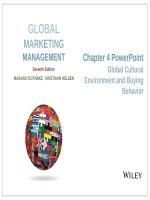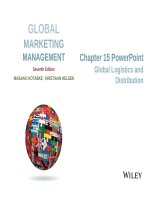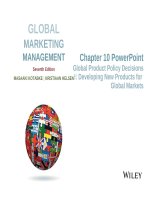Lecture Global marketing management (7th edition): Chapter 18 - Masaaki Kotabe, Kristiaan Helsen
Bạn đang xem bản rút gọn của tài liệu. Xem và tải ngay bản đầy đủ của tài liệu tại đây (3.4 MB, 23 trang )
GLOBAL
MARKETING
MANAGEMENT
Seventh Edition
MASAAKI KOTABKE | KRISTIAAN HELSEN
Chapter 18 PowerPoint
Marketing Strategies for
Emerging Markets
Chapter Overview
1. Emerging Markets
2. Competing with New Champions
3. Targeting/Positioning Strategies in Emerging
Markets—BOP or No BOP?
4. Entry Strategies for Emerging Markets
5. Product Policy
6. Pricing Strategy
7. The Distribution Challenge
8. Communication Strategies for Emerging Markets
Chapter 18
Copyright © 2017 John Wiley & Sons,
Inc.
2
Introduction
• Emerging markets are becoming more attractive as
developed markets are saturated.
• Some emerging markets are already the top
producers for MNCs—McDonald’s in Moscow.
• MNCs also are coming from emerging markets—
Tata Motor from India, Emirates Air from Dubai.
• MNCs still face obstacles to trade in emerging
markets.
Chapter 18
Copyright © 2017 John Wiley & Sons,
Inc.
3
1. Emerging Markets
• Emerging markets (EMs) refer to economies that
are in the process of rapid growth and
industrialization.
• Label is indistinct, and membership varies with
source. Usual members are Brazil, China,
Indonesia, and India.
• Transition economies—those changing from a
centrally planned economy to free market—are also
in this group.
Chapter 18
Copyright © 2017 John Wiley & Sons,
Inc.
4
1. Emerging Markets
• BRICs—Brazil, Russia, India and China. Predicted
to eclipse the G7 economies by 2027.
• Next Eleven (N-11)—Bangladesh, Egypt,
Indonesia, Iran, South Korea, Mexico, Nigeria,
Pakistan, Philippines, Turkey, and Vietnam.
Expected to follow BRIC in surpassing the G7
economies.
Chapter 18
Copyright © 2017 John Wiley & Sons,
Inc.
5
1. Emerging Markets
• Characteristics of Emerging Markets
– Low per capita income and rapid economic
development
– Youthful populations
– Chronic shortage of resources
– Huge within market diversity
– Weak and highly variable infrastructure
– Unbranded competition
– Technology is underdeveloped
– Poorly developed marketing infrastructure
Chapter 18
Copyright © 2017 John Wiley & Sons,
Inc.
6
Exhibit 181:
Economic
and
Demographi
c
Comparison
: Emerging
Markets
versus
G7
Countries
Chapter 18
Copyright © 2017 John Wiley & Sons,
Inc.
7
Exhibit 18-2: The World’s Largest Shopping
Malls
Chapter 18
Copyright © 2017 John Wiley & Sons,
Inc.
8
Exhibit 18-3:
Challenges in Myanmar’s Business
Environment
Chapter 18
Copyright © 2017 John Wiley & Sons,
Inc.
9
2. Competing with the New Champions
• In the Fortune Global 500 ranking of 2015, almost
100 companies hailed from China, India, Brazil,
Mexico, and Russia.
• The New Champions
– Jollibee’s, a Filipino burger chain, is challenging
McDonalds in Asia, the Middle East, and the U.S.
– Haier is the world’s leading appliance maker by sales
volume and one of China’s most famous brands. In
the U.S., 30 percent of households own a Haier
product.
Chapter 18
Copyright © 2017 John Wiley & Sons,
Inc.
10
2. Competing with the New Champions
• What makes emerging market firms successful?
–
–
–
–
Create customized offerings
Develop business models to overcome obstacles
Deploy latest technologies (Exhibit 18-4)
Take advantage of cheap labor and train staff inhouse
– Scale up rapidly
– Invest in talent to sustain growth
Chapter 18
Copyright © 2017 John Wiley & Sons,
Inc.
11
Exhibit 18-4: Strategic Options
for Emerging-Market Companies
Chapter 18
Copyright © 2017 John Wiley & Sons,
Inc.
12
2. Competing with the New Champions
• Competing against the Newcomers
• How do MNCs deal with the newcomers?
– Go beyond low-cost sourcing in emerging markets
– Develop products in emerging markets and bring
them home
– Copy branding tactics used in emerging markets
– Team up with the new emerging giants
– Invest in growing mass markets in developing
countries
Chapter 18
Copyright © 2017 John Wiley & Sons,
Inc.
13
3. Targeting/Positioning Strategies
in Emerging Markets—BOP or No BOP?
• Bottom of the pyramid (BOP) or not?
– Defined as the 4 billion people in the world living on
less than $2 per day.
– Benefits of targeting BOP markets are:
• They are large and attractive as stand-alone entities
• Innovations developed in one BOP market can be
leverged in other markets
• Innovations originating in BOP markets can also be
launched in the MNC’s developed markets.
• Pursuing BOP markets forces an MNC to deliver value
for money, requiring relentless cost discipline.
Chapter 18
Copyright © 2017 John Wiley & Sons,
Inc.
14
4. Entry Strategies for Emerging Markets
• Timing of Entry is crucial. Reasons first movers
can fail:
– Unaware of market pitfalls like lack of demand
– Underdeveloped infrastructure like distribution
channels
– Steeper learning curve than later entrants
• Reasons first moves have advantages:
– Government support
– Pent-up demand for foreign goods
– Access to key marketing resources
– Higher productivity of marketing dollars
Copyright © 2017 John Wiley & Sons,
Chapter 18
Inc.
– Ability to outmaneuver larger,
established rivals
15
5. Product Policy
• Product Innovation
– Global corporations must adapt their offerings to the
local culture in emerging markets and be willing to
experiment with their product development and
marketing approaches.
– Backward or reverse innovation
– Frugal innovation
Chapter 18
Copyright © 2017 John Wiley & Sons,
Inc.
16
5. Product Policy
• Branding
– The wealthy can be sold the global brand
– The BOP group needs a brand that emulates local
brands
• Packaging
– Smaller sizes advisable to make products affordable
– Use local materials that are recyclable or
biodegradable
Chapter 18
Copyright © 2017 John Wiley & Sons,
Inc.
17
6. Pricing Strategy
• Thin margins and big volumes generally successful
• Saturate all price points to shut out local competition
• Improve cost structure of products by lowering fixed
and variable costs
• Marketers should keep in mind that emerging
market consumers are not always obsessed with
price
Chapter 18
Copyright © 2017 John Wiley & Sons,
Inc.
18
Exhibit 18-7: Hindustan Unilever’s Brand
Portfolio
Chapter 18
Copyright © 2017 John Wiley & Sons,
Inc.
19
7. The Distribution Challenge
• Be first on the shelf with rural retailers.
• Be prepared to create your own distribution system.
• Managing Distributor Relationships
– Four areas of distribution policy in which MNCs
should adapt the approaches used in developed
markets:
•
•
•
•
Chapter 18
Distributor partner selection criteria
Direct selling
Local autonomy
Exclusivity
Copyright © 2017 John Wiley & Sons,
Inc.
20
Exhibit 18-8: Project Shakti
Chapter 18
Copyright © 2017 John Wiley & Sons,
Inc.
21
8. Communication Strategies
for Emerging Markets
• Prioritizing promotion tasks—educating about
product use and benefits, raising brand awareness,
and creating brand image—is crucial.
• Push versus Pull Activities
– Push strategies are very important.
• Retailers have more power with trade-directed
promotions than in developed markets
• People shop more frequently, hence get more exposure
to push strategies via in-store promotions
Chapter 18
Copyright © 2017 John Wiley & Sons,
Inc.
22
8. Communication Strategies
for Emerging Markets
– Pull strategies should be altered
• Mass media typically less effective
• Targeted media preferred
• Communicate in the local language
• Mass Media vs. Nontraditional Marketing
Approaches
–
–
–
–
–
Tastes of consumers on EMs tend to be fickle
Illiteracy and language diversity difficult to navigate
Grassroots marketing can be effective
Reliance on social networks or opinion leaders
Event marketing can be a very potent tool
Chapter 18
Copyright © 2017 John Wiley & Sons,
Inc.
23









